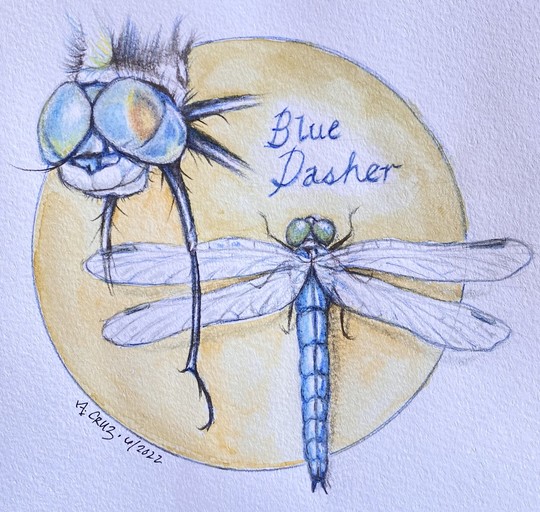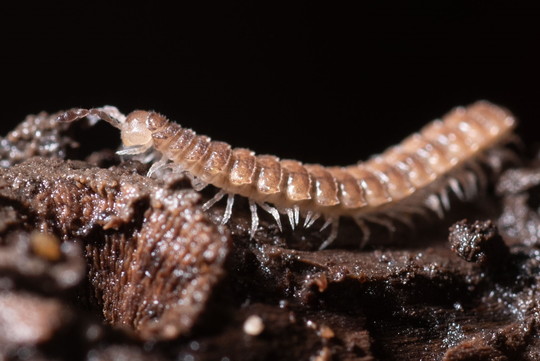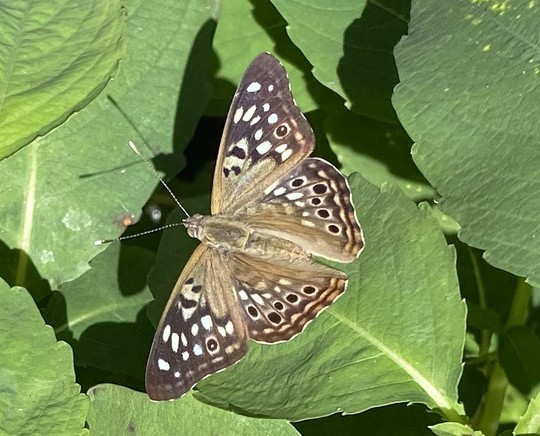 August 2022
Insects are key players in our ecosystem: They're pollinators, help break down and dispose of waste, keep pests at bay, act as scavengers, and are the sole food source for other animals. A rich source of protein, vitamins and minerals, many insects are considered delicacies in parts of the world.
An insect has six legs, a three-segmented body, segmented legs, compound eyes and two antennae. Examples include beetles, butterflies, ants, bees and dragonflies. While we commonly refer to all insects as "bugs," bugs are members of a specific order of insects, known as Hemiptera, which includes leafhoppers and stink bugs. Some small creatures, such as spiders and centipedes, are arthropods, not insects. All of them are invertebrates.
If you've spent any time outdoors in Minnesota this summer, you're likely very familiar with mosquitoes. From eyeless millipedes and bioindicator larvae to Hackberry emperor butterflies and garden spiders, allow us to introduce you to some other fascinating invertebrates you can find in our state.

Sitting down to sketch in nature allows me to discover the new in what I think is the familiar. I know what an American Robin looks like… until I try to draw it.
Once, as I was sketching a robin, it flew off and I noticed that the orange on the belly extends to the underwings — a trait I had never seen before in the hundreds of robins I had encountered. (Also, birds always seem to fly away as I’m trying to draw them.)
 Blue Dasher is a colorful dragonfly common throughout Minnesota. ILLUSTRATION by Alex Cruz
I find sketching in nature to be very grounding and therapeutic. My father died four years ago and my mother passed last year. Both my parents loved nature as well as art and they instilled in me passions for both. Sitting on the ground, I feel the warmth of the sun on me and as I put my pencil to paper, I not only feel a connection to the natural world around me, but I honestly feel the closeness of my loving parents watching me. I am thankful that places that provide such tranquility are protected by the Minnesota Department of Natural Resources.

I think creating community involves getting to know the natural world around you. State parks and trails allow me to feel part of a community that extends to all the reaches of our state.
My best-loved state park is Blue Mounds in southwestern Minnesota. It was my first experience of camping in a Minnesota state park and I remember waking up in my tent to the song of prairie-loving Eastern Meadowlark. Later that day, I explored the Sioux quartzite cliff, reaching an overlook where I could see the American bison herd. The stunning view made me pause and I could imagine the ancestors of those bison darkening the untilled prairie as far as the eye could see.
A treasured pastime of mine is combining hiking with birdwatching and there is no better place for this than Whitewater State Park in southeastern Minnesota. One of my fondest hiking memories in Minnesota is finding numerous mixed-species flocks of migrating birds along the Chimney Rock Trail. After a vigorous day of hiking, we returned to our walk-in campsite and calling above our tent was my lifer (the first time seeing a species) black-billed cuckoo!
Growing up searching for birds, I noticed that the friendly people I encountered didn’t look or sound like the people in my Puerto Rican family. Later, when I came out as a gay man, I felt even more isolated as I explored the natural world that ironically was also the place I felt most comfortable in. I hope that others see themselves (through me) as integral visitors to and valued stewards of the natural wonders of Minnesota.
Alex wants his artwork to inspire others to explore and protect the natural world around them.
|

This millipede is endemic to Mystery Cave and nowhere else in the world!
 PHOTO: Jean Krejca
This dipluran (two-tails) millipede was found last summer during an invertebrate inventory in Mystery Cave and is cave-adapted, so it's confined to a cave and can’t survive outside of it. Cave-adapted millipedes are eyeless, which means they would be easy prey. With no pigment to protect them from UV rays, they wouldn’t last long in the sunlight.
Dawn Ryan, cave supervisor at Forestville/Mystery Cave State Park
This large black and green dragonfly is named for its cobra-like clubtail.
 PHOTO: Cathy Perkins
The St. Croix Snaketail is one of North America’s rarest dragonflies, discovered only in 1993, and considered threatened in Minnesota. The nymph requires clean, highly oxygenated, flowing waters with a sandy bottom. It has only been found in the St. Croix River watershed in Minnesota and Wisconsin, and in a few sites in southeastern U.S. The adult is short-lived, relative to other dragonflies, and is rarely encountered.
Learn how you can help protect this and other dragonflies.
Kurt Mead, naturalist at Tettegouche State Park
One of the largest aquatic invertebrates in Minnesota, hellgrammites have extra appendages giving them the appearance of having a lot more than six legs.
After spending up to three years under water, hellgrammites (larvae of eastern dobsonflies) crawl out and metamorphose into adult. The huge, seven-inch dobsonflies live only a few days, just long enough to mate and lay eggs. They are usually found at the base of rocks in cold, fast moving water. The larvae are ferocious predators that eat any small, aquatic creature that goes by. They are in turn eaten by fish, especially smallmouth bass and trout. As they only live in healthy, unpolluted water they can be used by scientists as bioindicators.
Kris Hiller, naturalist at Jay Cooke State Park
Every summer Hackberry emperor butterflies emerge by the hundreds at Whitewater State Park, fluttering everywhere while trying to get moisture from all kinds of sources.
 PHOTO: Jay McLaren
Hackberry emperor caterpillars feed in groups on their only host, hackberry. In winter, late-stage caterpillars take refuge in rolled-up leaves, emerging in the spring to continue feeding. Adult butterflies emerge from the chrysalis in early summer and live for about two weeks. Adults get moisture from an odd assortment of sources, including hackberry flower nectar, feces, and rotting carcasses… they're not picky!
Val Cervenka, forest health program consultant
Sara Holger, naturalist at Whitewater State Park

These insects are important in both aquatic and terrestrial food webs, as they're eaten by other invertebrates, amphibians, reptiles, fish, birds, and mammals like bats.
The giant mayfly thrives in freshwater ecosystems that have sufficient oxygen levels. Their larvae are found in the water or burrowed down into the sediment. Adults can be seen on land in very high numbers (like millions!) in early to mid-summer evenings. Look for “the hatch” left when the adults emerge from the water. Mayflies are sensitive to chemical pollutants, increases in erosion and sediments in the water, and decreased dissolved oxygen levels.
Christa Drake, naturalist at Lake Bemidji State Park
These spiders consume pests such as flies, moths, beetles, wasps and mosquitoes.
 The banded Argiope and black and yellow Argiope (also known as garden spiders and orb weavers) can be found in gardens, fields and forests. Many orb weavers build a new web each day and are active during the evening hours. You can see hundreds of their webs in August when the dew covers the strands of their big, beautiful webs strung between prairie grass stems. You can identify them by the white zigzag pattern (called a stabilimentum) in the middle of the web where the spider often hangs.
Linda Radimecky, naturalist at Afton State Park

 You can find educational pollinator plantings that include exhibits at Afton, Buffalo River, Flaundrau, Fort Snelling, Lake Carlos, Minneopa, Myre-Big Island, Whitewater, Wild River and William O’Brien state parks.
Recent surveys suggest that eastern populations of Monarch butterflies have declined 90% from the 20-year average. Declines have also been observed in many other native pollinator species, such as wild bees and butterflies. One of the major factors causing these declines is habitat degradation and loss.
A Minnesota State Parks and Trails team worked on a restoration project to provide over 520 acres of additional habitat for Monarchs and other native pollinators. This habitat is within state parks and will be protected in perpetuity and managed to insure that it retains its quality through regular monitoring and periodic management such as prescribed burning, invasive species management and inter-planting. Additionally, millions of state park visitors annually will have the opportunity to learn about pollinators, pollinator habitat, and ways they can help support pollinator conservation.
|